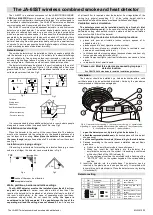
6-6
Ensuring Safety and Quality for an MCS+ Procedure
P/N 85213-30, Manual revision: B
Mechanical
hazards/rotating
parts
As with any equipment containing rapidly rotating parts, the potential for severe
injury exists if personal contact is made, or if clothing becomes entangled with
the moving parts. The MCS+ device contains a safety feature, designed to prevent
the centrifuge from spinning if the system has not been properly secured.
However, the operator should respect the usual precautions taken when working
with equipment containing rotating mechanical parts.
Power outlet
connection
To comply with the IEC 60601-1-1:2000 Standard for Medical Electrical Equip-
ment, general requirements for safety do not connect more than one multiple
portable socket outlet or extension cord to the system. In addition, do not power
the MCS+ device using a power cord other than the one originally supplied by
Haemonetics for your instrument. Always ensure the power cord is connected to
an appropriately grounded power source.
Communicable
disease
precautions
Despite testing and screening to detect communicable diseases such as hepatitis,
syphilis or HIV, the risk remains that the blood being processed may be infected.
The operator must take the appropriate precautions when handling blood prod-
ucts and disposing of blood-contaminated material, to ensure personal safety as
well as the safety of others who may come in contact with the material.
Proper handling of blood-contaminated material
If a leak or blood-spill should occur, it should be cleaned immediately. The oper-
ator should follow the local standard operating procedure outlining the steps to
follow and product(s) to be used for the disinfection of material contaminated by
blood.
If any blood-contaminated material must be returned to Haemonetics for further
inspection, the operator should consult the “RGA” Procedure, described in
Chapter 5.
Proper disposal of biologically contaminated materials
Any MCS+ disposable material used during an apheresis process is considered as
biologically contaminated. It must be disposed of according to local standard
operating procedure for the removal of such material and should not be mixed
with non-biologically contaminated waste.
Summary of Contents for LN9000-110-EWC
Page 2: ...2002 2006 Haemonetics Corporation All rights reserved...
Page 10: ...x Preface P N 85213 30 Manual revision B The Haemonetics MCS LN09000 220E ED...
Page 20: ......
Page 30: ......
Page 81: ...Maintaining the MCS Equipment 5 7 P N 85213 30 Manual revision B...
Page 85: ......
Page 86: ...5 12 Maintaining the MCS Equipment P N 85213 30 Manual revision B...
Page 100: ......
















































